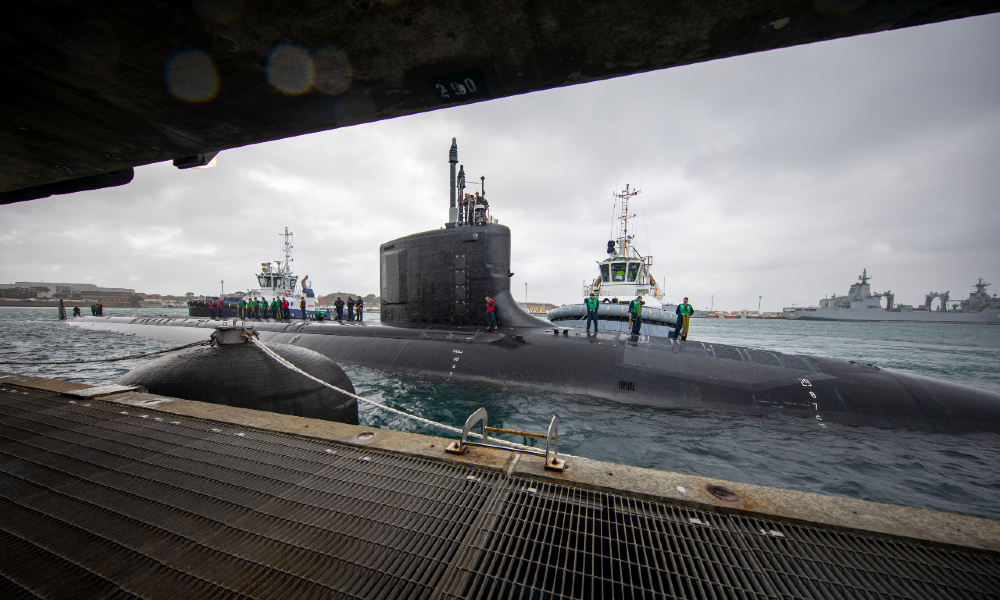The United States and Australia’s AUKUS Delusion

Published by The Lawfare Institute
in Cooperation With

Editor’s Note: One of the biggest diplomatic accomplishments of the Biden administration is the Australia-United Kingdom-United States agreement, known by the uninspiring abbreviation AUKUS. The Lowy Institute’s Sam Roggeveen argues, however, that the broader U.S. commitment to Asia is hollow. Under both Democratic and Republican leadership, the United States has not shown the will or invested in the capability to defend Asia as China rises.
Daniel Byman
***
There’s a dark joke doing the rounds in Australia that AUKUS is designed to manage the security problems created by AUKUS.
Like many jokes, this one relies on exaggeration to make its point. AUKUS, the tripartite initiative announced in September 2021 to sell eight nuclear-powered attack submarines to Australia and cooperate on other cutting-edge military technologies, is a response to reasonable fears about China’s ambitions to become the dominant strategic power in Asia. But it is also true that AUKUS, and the tighter U.S.-Australian alliance it creates, will expose Australia to danger. As a formal U.S. ally since 1951, Australia is used to that. The U.S.-Australian alliance has always come with obligations and risks, including of direct military attack on account of the U.S. communications and spying facilities that Australia hosts on its shores. In exchange, Australia gets the security benefits of U.S. maritime power and nuclear deterrence. AUKUS, and the associated U.S. basing arrangements announced since, raise these risks to new levels.
So why did Australia do it? At its heart, AUKUS is a wager on the United States’s willingness to maintain its leadership in Asia as China rises to challenge it. It is a bet that the United States has the resources and political will to stare down China’s attempt to overturn the post-World War II strategic order in Asia.
Starting with President Obama’s “pivot” to Asia in 2011, and then with greater emphasis under Trump and Biden, the United States has tried to convince the world that a strong China is inimical to U.S. interests and that China’s rise as a strategic power must be resisted. It is not a stretch to say that the United States has begun to see China as an enemy. This effort has succeeded in Australia—AUKUS is a sure sign of that. The United States has evidently convinced itself of China’s enemy status too; journalists and commentators routinely report that in a deeply divided Washington, the only issue uniting Republicans and Democrats is antipathy to China.
But this is a delusion. Both countries are wrong. Not about China, which clearly has ambitions to become the leading power in Asia and to push the United States out. The delusion lies in the belief, which Australian and American policymakers share, that Washington has sufficient motivation and will to resist this power shift.
The evidence does not back this up. As Robert Blackwill and Richard Fontaine write in “Lost Decade,” their recent book on the Obama administration’s 2011 decision to pivot to Asia, “America’s position in Asia today is weaker than when the Pivot was announced. The military balance has deteriorated in China’s direction, the US economic agenda has become ever-less ambitious, and America’s diplomatic engagement has proved inconsistent.”
If anything, Blackwill and Fontaine understate the problem. Given the scale of the challenge China poses, if the United States was committed to the contest, it would have taken much more dramatic action. It would have raised taxes to fund increased defense spending. It would have told the Europeans to look after themselves while the United States moved its forces to Asia. And the U.S. president would have stood before the American public to announce a new defining national mission dwarfing Cold War containment in scale.
Yet if anything, the 2024 presidential campaign suggested American politics is moving in the other direction. Donald Trump said that “the fascists, the Marxists, the communists, the people that we have that are actually running the country … are more dangerous … than Russia and China.” Kamala Harris nominated Iran as the United States’s greatest foreign adversary. When neither of the two presidential candidates can even identify the United States’s foe, it is difficult to believe the common Beltway claim that the U.S. is engaged in a new Cold War with China. Granted, it was Trump who elevated competition with China during his first term. Biden doubled down. But this has overwhelmingly been an economic initiative. Neither administration substantially increased America’s military commitment to Asia. Indeed, the size of the U.S. force committed to the region has barely grown since the fall of the Berlin Wall.
The mistake Australia has made is to regard AUKUS as evidence of U.S. commitment. AUKUS imposes few costs on Washington. In fact, it’s mostly upside. Australia offered to spend tens of billions of dollars on U.S. submarines, producing a fleet that the United States believes will be so tightly integrated with its own forces that it will effectively serve as an ancillary to the Pacific Fleet.
Do the new U.S. basing arrangements in Asia signal commitment to facing down China? There are four new facilities in the Philippines, expanded basing on Guam, a new U.S. submarine rotational presence in Western Australia, and expanded facilities for U.S. strategic bombers at one of Australia’s northern air bases. It sounds impressive. A recent Washington Post report described the Australian air base as “a potential launchpad in case of conflict with China” that is positioned “less than 2,000 miles from the emerging flash points of the South China Sea.”
But 2,000 miles makes for an awfully distant launchpad. In fact, it’s slightly farther than flying from the existing U.S. bomber base in Guam. The Wall Street Journal was closer to the truth by dubbing the basing initiative a “scatter and survive” strategy. “Scattering” implies that the United States is not so much reinforcing its presence in Asia as dispersing it to far-flung bases to counter the threat of China’s missile arsenal. If anything, it represents a minor retrenchment from the main theater of a future war with China, not a reinforcement. The word “survive” is also apposite: The basing effort implies an effort to withstand a Chinese assault but not to defeat it.
Still, even the Journal tried to put a gloss on it, implying that the new bases were a cunning plan to bankrupt Beijing: “Positioning bombers in Australia would force Beijing to decide whether to use its most costly long-range missiles to hit targets that far away.” If the idea is to build more bases until China runs out of money to build more missiles, Washington may need to think again; the economics of such a contest would appear unfavorable.
Which raises the broader question of whether the United States could ever take more dramatic military steps to counter China’s growth, and what would happen if it did. A handful of new bases is a wholly inadequate response, yet it may be the limit of what the United States can do. Even if Washington was prepared (and could afford) to send a flood of troops and equipment to the region, which country would host them? And if that problem was overcome, the United States would need to account for the high likelihood that Beijing will counter a U.S. build-up with one of its own. Despite China’s economic headwinds, its military spending as a percentage of gross domestic product remains lower than that of the United States. Moreover, it doesn’t have the same global military commitments as the United States, so it can focus on its own region. In an arms race, China would have the advantage.
The likelihood, then, is that Asia’s drift away from U.S. hegemony and toward a balance of power, which has been underway since the end of the Cold War, will continue. This shouldn’t be read as a judgment on American courage or character. Washington’s behavior reflects the limits of U.S. resources and a reasonable assessment of the threat China poses. Certainly, Beijing’s bid to undermine the U.S.-led order in Asia is bad news for allies such as Japan, South Korea, and Australia, but it is far from catastrophic for the United States itself, which maintains a huge margin of security that will remain intact even if China comes to dominate Asia.
Australia doesn’t face a choice between U.S. hegemony and Chinese hegemony, because the first of those is already lost and won’t be regained. Australia’s choice is between Chinese hegemony and a regional balance of power in which the United States plays a slowly diminishing part. In that world, doubling down on the alliance through AUKUS looks like a bad wager. Australia should be betting on itself and on its regional partners.





